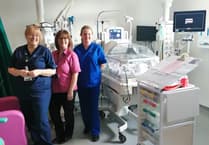A ‘social care crisis’ is claimed to be on the horizon in Ceredigion as falling healthcare bed numbers, staff recruitment difficulties and delayed discharges threaten the lives of patients.
Former Liberal Democrat Ceredigion MP and chair of the north of the county’s Forum for Older People’s Care, Mark Williams, told the Cambrian News before Christmas the situation facing the sector was a ‘ticking time bomb’.
Since then, retired Aberystwyth care worker George Holloway has articulated his fears over Welsh NHS plans to discharge patients from hospitals without a social care package in place.
This is part of the Welsh Government’s strategy to address delayed discharges – or ‘bed blocking’ – when sufficient care services are unavailable to safely allow patients to return home or to other care settings.
The British Medical Association and leading doctors have already rejected plans to change guidance and the ‘risk threshold’ by which patients can be discharged – saying it is indicative of a system at breaking point.
But a Welsh Government spokesperson said the guidance was issued because of the extreme pressure on hospitals and the increasing levels of high-risk people needing to be admitted for urgent and emergency medical care.
In Ceredigion, some politicians and advocacy organisations argue the state of social care is in a particularly perilous position due to recruitment difficulties and a rapidly ageing population.
They point to a declining number of care homes, hospital beds and social care staff - while there is also concern about an increase in discharge delays.
Clearly discharge delays are a top priority for Hywel Dda University Health Board. Bosses say there is currently an ‘extreme’ risk to ‘consistent delivery of timely urgent and emergency care’ at its hospitals. The situation is so severe it has merited the health board’s highest risk rating of 20.
The health board attributes the circumstances in part to ‘delays in discharges across the care system which are beyond the direct influence of the health board.’
It is true there are pronounced difficulties across the Welsh NHS – and it is a national problem with mostly national solutions. Any patterns specific to HDUHB or Ceredigion are difficult to illustrate.
Despite a reluctance from HDUHB and other regional boards to provide helpful figures to illustrate the daily reality of discharge delays, there is publicly available information up to February 2020, when the data stopped being gathered due to the pandemic.
Data obtained through a Freedom of Information request shows there were 295 delayed discharges across HDUHB hospitals in February, including 19 at Bronglais Hospital in Aberystwyth. The health board confirmed there were also about 300 in January. Strikingly this is a number broadly in keeping with larger health boards in Cardiff and south Wales which cater to much larger populations.
The numbers also equate to about a third of all the health board’s available beds. In February 2020, the discharge delay figure was closer to just five per cent of beds. It is a figure that has been steadily rising since 2010, according to Welsh Government data – after hovering at between two and three percent between 2010 to 2018.

The Cambrian News asked HDUHB for the annual average for monthly delayed discharges from 2015 to 2023 - but was provided with data for only February 2023 in addition to publicly available figures.
Keith Jones, director of secondary care, Hywel Dda University Health Board told the Cambrian News: “The number of people across the Hywel Dda University Health board who completed the acute phase of their care on Wednesday, 23 March was 311 with 116 of these able to leave hospital subject to availability of the necessary supporting capacity to support their safe discharge or transfer of care.
"These numbers can vary which reflects daily fluctuations in staffed capacity across the wider health and social care sector and we continue to work our clinical teams and local authority partners to transform our urgent and emergency care pathways and reduce the number of patients waiting to access the next phase of their care.”
The Cambrian News also asked for daily, weekly and monthly figures last Wednesday (22 March) from several health boards and only received data back from Powys Teaching Health Board.
Prior to the UK Government’s public service cuts throughout the 2010s, there were roughly 1,300 beds across HDUHB and now there are about 1,120. But encouragingly, bed numbers have increased at Bronglais by about 10 per cent since 2015.
The latest Welsh Government figures from February 2020 show a rate of discharge delay per 10,000 people aged 75 or older in Ceredigion of about 30 per cent, the eighth highest rate of any region in Wales. In February 2010 it was below 10 per cent.
There are only 15 registered elderly care homes in Ceredigion, which is the fourth lowest number of any region in Wales. It has the second lowest number of care homes if you include all types.
There has been widespread concern about the loss of the council-run Bodlondeb care home in Penparcau and the privately operated Abermad nursing home near Llanilar in recent years.
Mr Holloway, who worked for Ceredigion social services as a home carer and then a qualified social worker, retiring 11 years ago, expressed his concerns about the Welsh Government’s discharge strategy when it was announced in January.
“It seems to be the final knockings of the great plan to transform health and social care in Wales,” he said. “For the past decade or so, the emphasis has been to move to a health service where ‘prevention is better than cure’ and hospitals should only be a last resort.
“Health and social care providers are brought closer to one another to try to fill in the gaps in current provision. Hubs will be created in every locality so there is one stop access to GPs, district nurses, social workers and other services such as minor ops, or physiotherapy etc.
The number of people in Ceredigion are giving care to someone now — without being paid
“Much has been made of creating ‘resilient communities’, ones in which many of the tasks undertaken by the statutory services will in future be undertaken by friends, relatives or neighbours all coming together to rally around.
“To kick start this utopia, around the middle of 2017, just after the county council elections, the then-Ceredigion County Council Cabinet started to consult with the public... about whether people would prefer to stay in their own homes or go into care - possibly some miles away.
“All the while, the authority knew that there was insufficient care in the community to go around and at the same time closing the much-loved Bodlondeb Residential Home in Penparcau. There has been an election since and so there have been changes in personnel (but some of the responsible cabinet members are still there).
“At the same time, Hywel Dda has been busily closing beds at Bronglais Hospital and trying to ensure that dementia patients be integrated into the general wards to further reduce bed numbers.
“The question of bed blocking or more correctly ‘delayed discharges’ remains despite best efforts and there are a number of reasons for this, without making reference to the planning capabilities of the respective executives.
“If the social worker can’t arrange help due to lack of resources, the social worker must ensure the person is in a place of safety, even if it means bed blocking. So, if health and social care bodies are shedding beds and have no resources to meet the need placed on services at home, how does this crisis get resolved?
“Cynically, if vulnerable people have some kind of visibility while in the ranks of the delayed discharges, do they then become invisible and forgotten when they leave hospital, becoming one of the uncounted vulnerable?
“Can we rely on resilient communities? Given now that it is not unusual for grown-up children to be working far from home or, as people live longer, have other caring responsibilities to meet.
The proportion of Ceredigion’s population will be aged over 65 within 17 years
“Most importantly can they be as effective as a decently paid, properly trained and regulated professional workforce? Yet it’s not right to lay the blame for the care crisis in Ceredigion solely at the doors of the county council and Hywel Dda.
“While there have been some questionable decisions made in enacting this policy of transforming care, the policy itself belongs to the Welsh Government.
“The Westminster and Welsh governments need to grasp the nettle and come up with some kind of national template for solving these vital issues, acknowledging the need for extensive investment. The Office for National Statistics (ONS) put the amount of money informal carers save the government at £57bn per year.
“It’s about time the ‘powers that be’ stopped guilt tripping the public into papering over these massive cracks.”
The Cambrian News asked HDUHB and Ceredigion County Council for data on the total care workforce in the county or region and how this has changed over time. We were not provided with that information – though struggles recruiting care staff are well documented and national in scope.
Data from the ONS shows 7,246 people in Ceredigion were looking after someone without being paid when the census was carried out in March 2021 – equivalent to 10.5 per cent of the population over 5 years old in the area.
The county’s population of people aged over 65 is projected to increase from around a quarter to a third in under two decades, according to a report that went before Ceredigion County Council in December.
By 2040 Ceredigion’s population of over-85s is set to grow a staggering 70 per cent according to Welsh Government data.
The draft report looks at a potential dementia crisis, an influx of unpaid carers and an increasingly excessive strain on hospitals and care suppliers.
The percentage of Ceredigion’s population is offering free care to someone over 5 years of age
Andrew Carruthers, director of operations at Hywel Dda University Health Board, said: “Social care and health teams continue to do everything possible to support people who are well enough to leave hospital but need ongoing care.
“We work closely with our local authorities as there are difficulties in discharging some patients due to staffing challenges in the social care sector, similar to what the NHS is facing.
“We also work closely with families of patients waiting for a formal package of care, when appropriate, to establish whether they can provide support and care on a short term, temporary basis or whether their loved one could be supported in a temporary residential or nursing care setting.
“Spending as little time in hospital is an important part of a patient’s recovery and protects them from negative consequences of hospital admission, such as hospital acquired infection, falls and a loss of independence and means that NHS beds can be freed up for others with urgent care needs.”
A Ceredigion County Council spokesperson said: “Ceredigion has a relatively low number of discharge delays and the close working between the local authority and the health board helps to keep this as low as possible.
“Currently there are a number of vacancies across the care home sector and there is no associated delay in discharging patients due to lack of capacity.
“There are a range of beds available including EMI residential and in response to the query regarding Bodlondeb, this home when open was not registered for EMI Residential/nursing.”
The value of informal care provided for free, according to UK government figures
A Welsh Government spokesperson said: “Health and care services in Wales, like the rest of the UK, are working incredibly hard to respond to a complex range of ongoing and significant challenges which are affecting admissions, flow and the discharge of people from hospital.
“We are doing everything we can to ensure people can return home as quickly as possible with appropriate care. This includes investing record amounts in health and care services and recruiting more social care workers.
“The guidance on discharging patients was to support clinical decision making and discharge arrangements for people who are medically fit to leave hospital, but where there are delays in finalising care packages. It does not suggest that frail and sick people who need continuing care in hospital should be discharged.
“This winter we have secured more than 500 extra community beds and social care packages to help move people out of hospital to get care closer to home and are working to deliver even more.”
The spokesperson said £70m has been invested to ensure all social care workers continue to get paid at least the Real Living Wage – in a bid to boost recruitment.
Welsh Liberal Democrat leader Jane Dodds MS said: “We urgently need a clear-cut plan from the Welsh Government on how they are going to tackle the crisis in social care and ensure ambulances aren’t left queuing outside hospitals and people who are medically fit to be discharged from emergency departments can access the social care they need to leave safely.”




